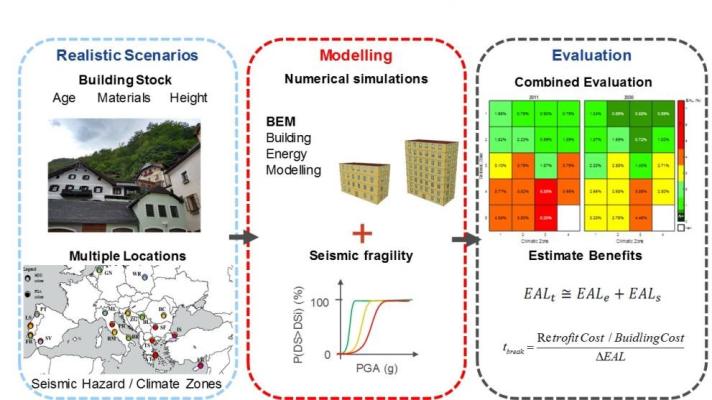Retrofitting existing buildings to make them seismically resistant and at the same time energy efficient may be unaffordable for many.
That's why researchers at the European Commission's Joint Research Centre are exploring novel solutions for simultaneous energy and seismic retrofitting under the exploratory research programme.
Challenge
Of the current EU building stock, 80% was built before the ’90s, 40% before the ’60s, and a considerable amount is even older and classified as cultural patrimony. Renovating the existing modern and historical buildings in Europe is becoming increasingly important:
- the poor seismic performance of structures during recent earthquakes (e.g., in Italy, Greece, Croatia, Turkey) resulted in human deaths, severe injuries, and significant economic losses
- the low energy performance of buildings increases their energy consumption. Buildings are responsible for 40% of the overall power consumption in the EU
- buildings generate enormous amounts of demolition waste at the end of their lifetime. In Europe, the construction industry is responsible for one-third of the total waste.
- cultural heritage buildings often suffer irreparable damage during earthquakes
The aging European building stock needs to be upgraded to meet modern safety standards and to extend its lifetime. Renovation can also achieve significant reductions in energy consumption and CO2 emissions.
Presently less than 1% of the EU building stock is being renovated annually. Recognising the importance of building renovation, the European Green Deal emphasises the need for the EU Member States to engage in a Renovation Wave so as to ’at least double the annual energy renovation rate of residential and non-residential buildings by 2030 and beyond. In addition, the New European Bauhaus initiative envisions combining considerations of safety, sustainability and aesthetics in the building sector to support the EU Green Deal.
Innovations ‒ Proposed Solutions
To date, the energy and seismic retrofitting of buildings are generally treated separately. Recently, researchers at the JRC have been taking several steps beyond the state-of-the-art by exploring novel materials and cost-effective solutions for achieving integrated seismic and energy retrofitting. The JRC project Innovative seismic and energy retrofitting of the existing building stock (iRESIST+) and the H2020-MSCA-IF projects NOvel TImber Composites for Energy and Seismic Upgrading of Buildings (NOTICE-EUB) and Smart Textiles for RETrofitting and monitoring of Cultural Heritage buildings (STRETCH), hosted at the JRC, seek to increase the buildings renovation uptake in the EU by investigating advanced materials (e.g. textile reinforcement), organic materials (e.g. wood) and innovative solutions tackling the poor seismic and energy performance of the existing building stock simultaneously.
Impact
Combined seismic and energy retrofitting of the existing EU buildings is potentially beneficial for all earthquake-prone communities and the general society by reducing building energy consumption, operation costs, and greenhouse gas emissions. House owners and governments renovating buildings of societal or cultural importance will benefit from reduced costs of the proposed retrofit concepts compared to separate seismic and energy retrofit interventions. This research will also help the construction industry: developing appropriate retrofit strategies and policies to incentivise building upgrades will increase demand for retrofit specialists.
The explored innovations can significantly reduce the costs of meeting both seismic and energy performance requirements simultaneously. Millions of buildings will need hybrid retrofitting per year in the EU to reach the 2‒3% annual renovation targets. The research aims at prolonging buildings’ lifetime with respect to the EU environmental goals: minimising the drain on non-renewable construction resources and preventing demolition waste.
A common approach for building performance classification is proposed to assess the impact of the iRESIST+ retrofit scheme on the renovation of the EU building stock. The methodology will allow to assess whether energy efficiency and disaster-resilient practices can be integrated. This approach was investigated by numerical modelling of the energy and seismic performance of European buildings. Initially, 20 case study locations across Europe have been selected, representing a wide range of seismic hazard levels and climatic demands.
Reductions up to 32% in Primary Energy consumption for heating and cooling, as well as reductions up to 38% in terms of CO2 emissions, could be achieved when retrofitting 3% of the existing building stock annually with the proposed retrofit scheme.
Additionally, it was found that already in regions of moderate seismicity, combined interventions present financial benefits over energy retrofitting alone. Finally, in zones in which seismic retrofitting is essential due to higher seismic activity, performing the combined retrofit at once instead of separate interventions showed a significant reduction in the intervention’s payback period.


